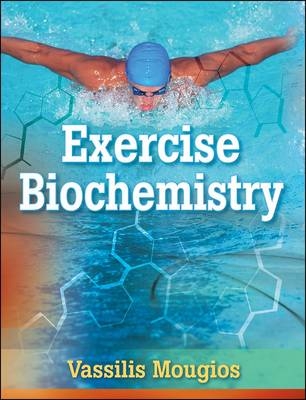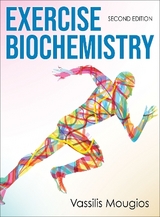
Exercise Biochemistry
Human Kinetics (Verlag)
978-0-7360-5638-0 (ISBN)
- Titel erscheint in neuer Auflage
- Artikel merken
Exercise Biochemistry brings an admittedly difficult and technical subject to life. Extremely user- and student-friendly, it is written in conversational style by Vassilis Mougios, who poses and then answers questions as if in conversation with a student. Mougios does an excellent job of making the information interesting by using simple language without compromising scientific accuracy and content. He also uses ample analogies, related works of art, and numerous illustrations to drive home his points for readers.
The result is that Exercise Biochemistry is a highly informative and illuminating text on the effects of exercise on molecular-level functioning. It presents the basics of biochemistry as well as in-depth coverage of exercise biochemistry. The book uses key terms, sidebars, and questions and problems posed at the end of each chapter to facilitate learning. It also covers metabolism, endocrinology, and assessment all in one volume, unlike other exercise biochemistry books.
In exploring all of these topics, Exercise Biochemistry makes the case for exercise biochemistry to have a stand-alone textbook. In fact, this book will encourage more universities to introduce exercise biochemistry courses to their curricula. Having the necessary topics of basic biochemistry in a single volume will facilitate the work of both instructors and students.
Exercise Biochemistry will also be useful to graduate students in sport science who have not been formally introduced to exercise biochemistry during their undergraduate programs. Additionally, it can supplement exercise physiology textbooks with its coverage of the molecular basis of physiological processes. This book is also for physical education and sport professionals who have an interest in how the human body functions during and after exercise. And this book is addressed to health scientists who are interested in the transformations in human metabolism brought about by physical activity.
The book is organized in four parts. Part I introduces readers to biochemistry basics, including chapters on metabolism, proteins, nucleic acids and gene expression, and carbohydrates and lipids. Part II consists of two chapters that explore neural control of movement and muscle contraction. The essence of the book is found in part III, which details exercise metabolism in its six chapters. Included are chapters on carbohydrate, lipid, and protein metabolism in exercise; compounds of high phosphoryl transfer potential; effects of exercise on gene expression; and integration of exercise metabolism. In part IV, the author focuses on biochemical assessment of people who exercise, with chapters on iron status, metabolites, and enzymes and hormones. Simple biochemical tests are provided to assess an athlete's health and performance.
Exercise Biochemistry is a highly readable book that serves as a source for understanding how exercise changes bodily functions. The text is useful for both students and practitioners alike.
Vassilis Mougios, PhD, is an associate professor of exercise biochemistry at the University of Thessaloniki in Greece. A teacher of exercise biochemistry, sport nutrition, and ergogenic aspects in sport for 17 years, Mougios served on the Scientific Committee of the 2004 Pre-Olympic Congress. He has coauthored many articles in international scientific journals and has done research on muscle contraction, exercise metabolism, biochemical assessment of athletes, and sport nutrition. Mougios is a member of the American College of Sports Medicine, the American Physiological Society, the European College of Sport Science, the New York Academy of Sciences, and Index Copernicus Scientists. He serves as a reviewer for the Journal of Applied Physiology, the British Journal of Sports Medicine, the European Journal of Clinical Nutrition, Acta Physiologica, Annals of Nutrition and Metabolism, and Obesity Research. In his leisure time, he enjoys bicycle riding, hiking, and photography.
Contents
Preface
A Guided Tour for the Student
Part I Biochemistry Basics
Chapter 1 Introduction
-1.1 Chemical Elements
-1.2 Chemical Bonds
-1.3 Molecules
-1.4 Ions
-1.5 Polarity Influences Miscibility
-1.6 Solutions
-1.7 Chemical Reactions and Equilibrium
-1.8 pH
-1.9 Acid-Base Interconversions
-1.10 Classes of Biological Substances
-1.11 Cell Structure
-Problems and Critical Thinking Questions
Chapter 2 Metabolism
-2.1 Free-Energy Changes Earmark Metabolic Reactions
-2.2 Determinants of Free-Energy Change
-2.3 ATP, the Energy Currency of Cells
-2.4 Phases of Metabolism
-2.5 Oxidation-Reduction Reactions
-2.6 Overview of Catabolism
-Problems and Critical Thinking Questions
Chapter 3 Proteins
-3.1 Amino Acids
-3.2 The Peptide Bond
-3.3 Primary Structure of Proteins
-3.4 Secondary Structure
-3.5 Tertiary Structure
-3.6 Denaturation
-3.7 Quaternary Structure
-3.8 Protein Function
-3.9 Oxygen Carriers
-3.10 Myoglobin
-3.11 Hemoglobin
-3.12 The Wondrous Properties of Hemoglobin
-3.13 Enzymes
-3.14 The Active Site
-3.15 Enzymes Affect the Rate but not the Direction of Reactions
-3.16 Factors Affecting the Rate of Enzyme Reactions
-Problems and Critical Thinking Questions
Chapter 4 Nucleic Acids and Gene Expression
-4.1 Introducing Nucleic Acids
-4.2 Flow of Genetic Information
-4.3 Deoxyribonucleotides, the Building Blocks of DNA
-4.4 Primary Structure of DNA
-4.5 The Double Helix of DNA
-4.6 The Genome of Living Organisms
-4.7 DNA Replication
-4.8 Mutations
-4.9 RNA
-4.10 Transcription
-4.11 Genes and Gene Expression
-4.12 Messenger RNA
-4.13 Translation
-4.14 The Genetic Code
-4.15 Transfer RNA
-4.16 Translation Continued
-4.17 In The Beginning, RNA?
-Problems and Critical Thinking Questions
Chapter 5 Carbohydrates and Lipids
-5.1 Carbohydrates
-5.2 Monosaccharides
-5.3 Oligosaccharides
-5.4 Polysaccharides
-5.5 Lipids
-5.6 Fatty Acids
-5.7 Triacylglycerols
-5.8 Phospholipids
-5.9 Steroids
-5.10 Cell Membranes
-Problems and Critical Thinking Questions
Part I Summary
Part II Biochemistry of the Neural and Muscular Processes of Movement
Chapter 6 Neural Control of Movement
-6.1 Nerve Signals Are Transmitted in Two Ways
-6.2 The Resting Potential
-6.3 The Action Potential
-6.4 Propagation of an Action Potential
-6.5 Transmission of a Nerve Impulse from One Neuron to Another
-6.6 Birth of a Nerve Impulse
-6.7 The Neuromuscular Junction
-6.8 A Lethal Arsenal at the Service of Research
-Problems and Critical Thinking Questions
Chapter 7 Muscle Contraction
-7.1 Structure of a Muscle Cell
-7.2 The Sliding-Filament Theory
-7.3 The Wondrous Properties of Myosin
-7.4 Structure of Myosin
-7.5 Actin
-7.6 Sarcomere Architecture
-7.7 Mechanism of Force Generation
-7.8 Myosin Isoforms and Muscle Fiber Types
-7.9 Control of Muscle Contraction
-7.10 Excitation-Contraction Coupling
-Problems and Critical Thinking Questions
Part II Summary
Part III Exercise Metabolism
III.1 Principles of Exercise Metabolism
III.2 Exercise Parameters
III.3 Experimental Models Used to Study Exercise Metabolism
III.4 Five Means of Metabolic Control in Exercise
III.5 Four Classes of Energy Sources in Exercise
Chapter 8 Compounds of High Phosphoryl Transfer Potential
-8.1 The ATP-ADP Cycle
-8.2 The ATP-ADP Cycle in Exercise
-8.3 Creatine Phosphate
-8.4 Window to the Sarcoplasm
-8.5 Loss of AMP by Deamination
-Problems and Critical Thinking Questions
Chapter 9 Carbohydrate Metabolism in Exercise
-9.1 Glycogen Metabolism
-9.2 Exercise Speeds up Glycogenolysis in Muscle
-9.3 The Cyclic-AMP Cascade
-9.4 Recapping the Effect of Exercise on Glycogen Metabolism
-9.5 Glycolysis
-9.6 Exercise Speeds up Glycolysis in Muscle
-9.7 Pyruvate Oxidation
-9.8 Exercise Speeds up Pyruvate Oxidation in Muscle
-9.9 The Citric Acid Cycle
-9.10 Exercise Speeds up the Citric Acid Cycle in Muscle
-9.11 The Electron Transport Chain
-9.12 Oxidative Phosphorylation
-9.13 Energy Yield of the Electron Transport Chain
-9.14 Energy Yield of Carbohydrate Oxidation
-9.15 Exercise Speeds up Oxidative Phosphorylation in Muscle
-9.16 Lactate Production in Muscle During Exercise
-9.17 Features of the Anaerobic Carbohydrate Catabolism
-9.18 Utilizing Lactate
-9.19 Gluconeogenesis
-9.20 Exercise Speeds up Gluconeogenesis in the Liver
-9.21 The Cori Cycle
-9.22 Exercise Speeds up Glycogenolysis in the Liver
-9.23 Control of the Plasma Glucose Concentration in Exercise
-9.24 Blood Lactate Accumulation
-9.25 Blood Lactate Removal
-9.26 “Thresholds”
Problems and Critical Thinking Questions
Chapter 10 Lipid Metabolism in Exercise
-10.1 Triacylglycerol Metabolism in Adipose Tissue
-10.2 Exercise Speeds up Lipolysis
-10.3 Fate of the Lipolytic Products During Exercise
-10.4 Fatty Acid Degradation
-10.5 Energy Yield of Fatty Acid Oxidation
-10.6 Fatty Acid Synthesis
-10.7 Exercise Speeds up Fatty Acid Oxidation in Muscle
-10.8 Changes in the Plasma Fatty Acid Concentration and Profile During Exercise
-10.9 Interconversion of Lipids and Carbohydrates
-10.10 Plasma Lipoproteins
-10.11 A Lipoprotein Odyssey
-10.12 Effects of Exercise on Plasma Triacylglycerols
-10.13 Effects of Exercise on Plasma Cholesterol
-10.14 Exercise Increases Ketone Body Formation
-Problems and Critical Thinking Questions
Chapter 11 Protein Metabolism in Exercise
-11.1 Protein Metabolism
-11.2 Effect of Exercise on Protein Metabolism
-11.3 Amino Acid Metabolism in Muscle During Exercise
-11.4 Amino Acid Metabolism in the Liver During Exercise
-11.5 The Urea Cycle
-11.6 Amino Acid Synthesis
-11.7 Plasma Amino Acid, Ammonia, and Urea Concentrations During Exercise
-11.8 Contribution of Proteins to the Energy Expenditure of Exercise
-11.9 Effects of Training on Protein Metabolism
-Critical Thinking Questions
Chapter 12 Effects of Exercise on Gene Expression
-12.1 Stages in the Control of Gene Expression
-12.2 Which Stages in the Control of Gene Expression Does Exercise Affect?
-12.3 Kinetics of a Gene Product After Exercise
-12.4 Exercise-Induced Changes that May Modify Gene Expression
-12.5 Mechanisms of Exercise-Induced Muscle Hypertrophy
-12.6 Mechanisms of Exercise-Induced Mitochondrial Biogenesis
-Problems and Critical Thinking Questions
Chapter 13 Integration of Exercise Metabolism
-13.1 Interconnections of Metabolic Pathways
-13.2 Energy Systems
-13.3 Energy Sources in Exercise
-13.4 Choice of Energy Sources During Exercise
-13.5 Effect of Exercise Intensity on the Choice of Energy Sources
-13.6 Effect of Exercise Duration on the Choice of Energy Sources
-13.7 Interaction of Duration and Intensity: Energy Sources in Running and Swimming
-13.8 Effect of the Exercise Program on the Choice of Energy Sources
-13.9 Effect of Heredity on the Choice of Energy Sources in Exercise
-13.10 Conversions of Muscle Fiber Types
-13.11 Effect of Nutrition on the Choice of Energy Sources During Exercise
-13.12 Adaptations of the Proportion of Energy Sources During Exercise to Endurance Training
-13.13 How Does Endurance Training Modify the Proportion of Energy Sources During Exercise?
-13.14 Adaptations of Energy Metabolism to Anaerobic Training
-13.15 Effect of Age on the Choice of Energy Sources During Exercise
-13.16 Do Sex and Ambient Temperature Affect the Choice of Energy Sources During Exercise?
-13.17 The Proportion of Fuels Can Be Measured Bloodlessly
-13.18 Hormonal Effects on Exercise Metabolism
-13.19 Fatigue
-13.20 Central Fatigue
-13.21 Peripheral Fatigue
-13.22 Restoration of the Energy State After Exercise
-13.23 Metabolic Changes in Detraining
-Problems and Critical Thinking Questions
Part III Summary
Part IV Biochemical Assessment of Exercising Persons
IV.1 The Blood
IV.2 Aims and Scope of the Biochemical Assessment
IV.3 The Reference Interval
IV.4 Classes of Biochemical Parameters
Chapter 14 Iron Status
-14.1 Hemoglobin
-14.2 Hematologic Parameters
-14.3 Does Sports Anemia Exist?
-14.4 Iron
-14.5 Total Iron-Binding Capacity
-14.6 Transferrin Saturation
-14.7 Soluble Transferrin Receptor
-14.8 Ferritin
-14.9 Iron Deficiency
-Problems and Critical Thinking Questions
Chapter 15 Metabolites
-15.1 Lactate
-15.2 Estimating the Anaerobic Lactic Capacity
-15.3 Programming Training
-15.4 Estimating Aerobic Endurance
-15.5 Glucose
-15.6 Triacylglycerols
-15.7 Cholesterol
-15.8 HDL Cholesterol
-15.9 LDL Cholesterol
-15.10 Recapping Cholesterol
-15.11 Glycerol
-15.12 Urea
-15.13 Ammonia
-15.14 Creatinine
-Problems and Critical Thinking Questions
Chapter 16 Enzymes and Hormones
-16.1 Enzymes
-16.2 Creatine Kinase
-16.3 Aminotransferases
-16.4 Steroid Hormones
-16.5 Cortisol
-16.6 Testosterone
-16.7 Overtraining
-16.8 Epilogue
-Problems and Critical Thinking Questions
Part IV Summary
References
Suggested Readings
Answers to Problems and Critical Thinking Questions
Glossary
Index
About the Author
| Zusatzinfo | 8.5 |
|---|---|
| Verlagsort | Champaign, IL |
| Sprache | englisch |
| Maße | 216 x 279 mm |
| Gewicht | 1179 g |
| Themenwelt | Sachbuch/Ratgeber ► Sport |
| Studium ► 1. Studienabschnitt (Vorklinik) ► Physiologie | |
| Naturwissenschaften ► Biologie ► Biochemie | |
| ISBN-10 | 0-7360-5638-6 / 0736056386 |
| ISBN-13 | 978-0-7360-5638-0 / 9780736056380 |
| Zustand | Neuware |
| Haben Sie eine Frage zum Produkt? |
aus dem Bereich



